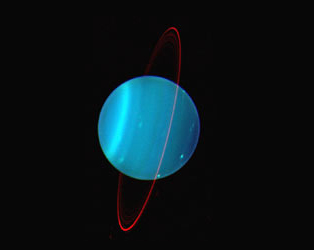On Thursday, August 16th, Earth will cross the equator and ring plane of Uranus, and astronomers all over the world will be on watch. The unusual geometry offers a unique view of the planet's atmosphere, satellites and ring system. "This won't happen again for a long time," says planetary researcher Heidi Hammel (Space Science Institute, Colorado). "We don't know what we're going to see. It's exciting."

This remarkable near-infrared image of Uranus, taken with adaptive optics at Keck Observatory in Hawaii, shows one of the planet's rings and bright cloud bands in the atmosphere, especially in the south polar region (left). Blue, green, and red represent 1.26, 1.62, and 2.1 microns, respectively. Click image for larger view of both hemispheres.
Lawrence Sromovsky, University of Wisconsin-Madison/ W. M. Keck Observatory.
Uranus's orbital period of 84 years means that we get ring-plane crossings only every 42 years. During the last one, in 1965, little was known about the distant planet, the ring system hadn't been discovered, space telescopes sounded like science fiction, and the 5-meter Hale telescope on Palomar Mountain was the world's largest. "To study Uranus, you need big telescopes," says Hammel. "This is really the first time we can do these kind of observations."
Because of Earth's own orbital motion, our planet actually crosses the Uranian ring plane three times in succession: on May 2, 2007, August 16, 2007, and February 20, 2008. The August event is by far the most favorable; Uranus will be less than a month from its opposition to the Sun (on September 9th), so it will be visible almost all night (in Aquarius). Another interesting fact is that December 7, 2007, is the date of Uranian equinox, when the Sun will cross the planet's equatorial plane.
Following a Pasadena, California, workshop in May 2006, astronomers have secured observing time on Keck, Hubble, the European Very Large Telescope, and at a host of smaller observatories. But not all observations are so time-critical. "We have been observing changes in Uranus's atmosphere for years," says Hammel. With the northern hemisphere of the steeply tilted planet receiving more and more sunlight, changes in cloud bands have actually progressed much faster than expected, she notes. "We've got a lot of atmospheric modeling to do."
Observations of the ring system are more time-dependent, explains Imke de Pater (University of California, Berkeley). Currently (between May 2nd and August 16th), astronomers have a rare opportunity to see the unlit side of the faint rings, albeit at an extremely low inclination, enhancing the appearance of dust structures because of backward scattering of sunlight by fine particles. For instance, two recently discovered tenuous dust rings are now much more pronounced, according to Mark Showalter (SETI Institute). In contrast, says De Pater, the bright Epsilon ring already became much darker last year, because of mutual shading among its relatively large particles. "Right now it's all but invisible," she says. "It's a very strange sight."
"The ring plane crossing is also the best opportunity to find small, embedded satellites in the ring system," explains Showalter. So-called shepherd satellites are still the only viable explanation for the sharp edges of the narrow Uranian rings, he notes. Searches for these objects must be carried out with the Hubble Space Telescope.
Observations of mutual occultations and eclipses among the Uranian satellites are probably the most time-critical. They will provide some information on albedo variations on the unmapped northern hemispheres of the five large satellites (back in 1986, Voyager 2 saw only the sunlit southern hemispheres as it flew by), but according to Showalter, the mutual events will also provide incredibly precise orbital information.
Amateurs with large scopes equipped for CCD imaging can also contribute to the Uranian-moon campaign.
The first preliminary results of the observing campaign have already been submitted in a paper to Science, says De Pater. But there's much more to come. "It's very important to obtain many observations at various wavelenghts simultaneously,' says Hammel. 'We won't have this opportunity again until 2049."
 1
1









Comments
HeadHollie19
April 16, 2010 at 5:56 am
When you're in not good state and have no money to move out from that, you would need to take the mortgage loans. Because it should help you for sure. I take bank loan every single year and feel good just because of it.
You must be logged in to post a comment.
You must be logged in to post a comment.